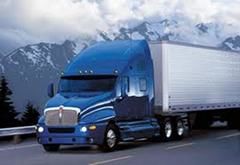Review Questions - Click On The Picture To Begin...

- Cargo should have at least one tiedown for each 25 feet of cargo
- On flat bed trailers or trailers without sides, no matter how small the cargo is, it should have at least two tiedowns holding it
- The combined strength of all cargo tiedowns must be strong enough to lift three times the weight of the piece of cargo tied down
- On flat bed trailers or trailers without sides, cargo that weighs more than 10,000 pounds does not require a tie down
Quote From The CDL Manual:
Cargo Tiedown - On flat bed trailers or trailers without sides, cargo must be secured to keep it from shifting and falling off. In closed vans, tiedowns can also be important to prevent cargo shifting that may affect the handling of the vehicle. Tiedowns must be of the proper type and proper strength. The combined strength of all cargo tiedowns must be strong enough to lift one and one-half times the weight of the piece of cargo tied down. Proper tiedown equipment must be used, including ropes, straps, chains, and tensioning devices (winches, ratchets, clinching components). Tiedowns must be attached to the vehicle correctly (hook, bolt, rails, rings).
Cargo should have at least one tiedown for each 10 feet of cargo. Make sure you have enough tiedowns to meet this need. No matter how small the cargo is, it should have at least two tiedowns holding it.
There are special requirements for securing various heavy pieces of metal. Find out what they are if you are to carry such loads.
- Putting a divider between the trailer doors and the product to keep anyone from seeing what product is being hauled
- Placing cargo in the center of the trailer for proper load balance
- Only loading one layer of product to avoid a rollover
- Securing the front, back, or sides of a piece of cargo to keep it from sliding
Quote From The CDL Manual:
Blocking is used in the front, back and/or sides of a piece of cargo to keep it from sliding. Blocking is shaped to fit snugly against cargo. It is secured to the cargo deck to prevent cargo movement.
Bracing also is used to prevent movement of cargo. Bracing goes from the upper part of the cargo to the floor and/or walls of the cargo compartment.
- 1
- 4
- 3
- 2
Quote From The CDL Manual:
Cargo should have at least one tiedown for each 10 feet of cargo. Make sure you have enough tiedowns to meet this need. No matter how small the cargo is, it should have at least two tiedowns holding it.








 TT On Facebook
TT On Facebook